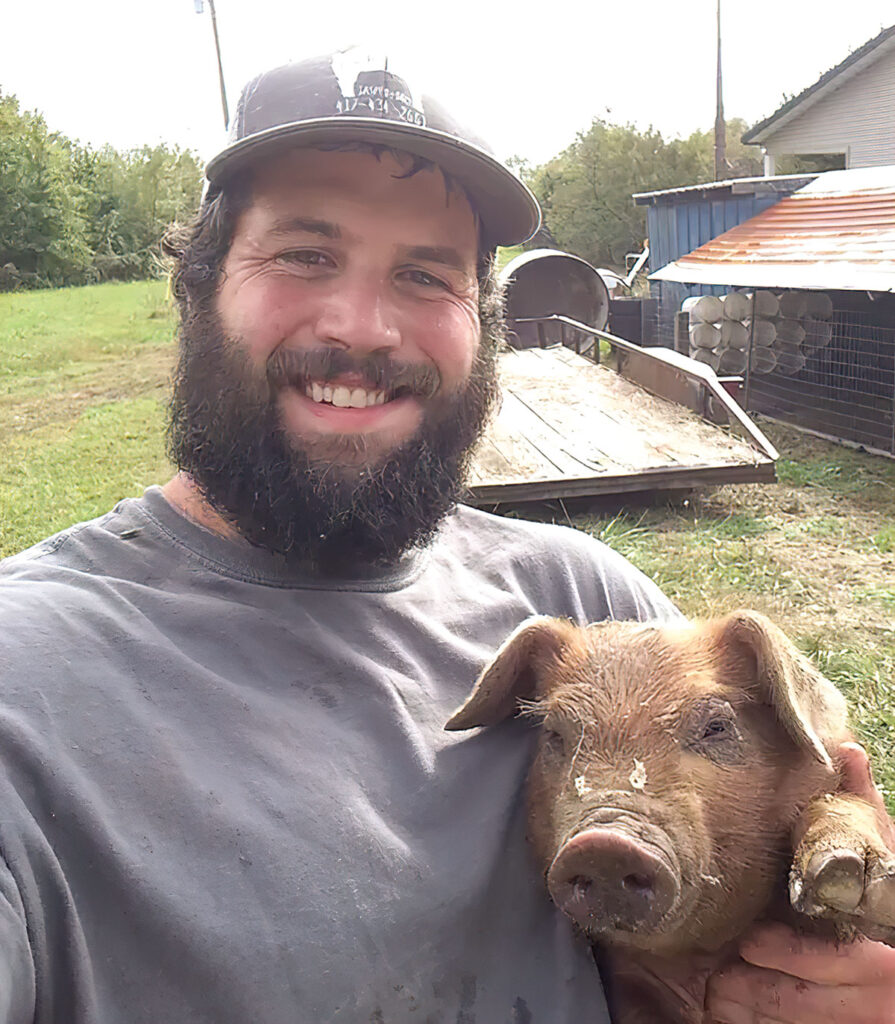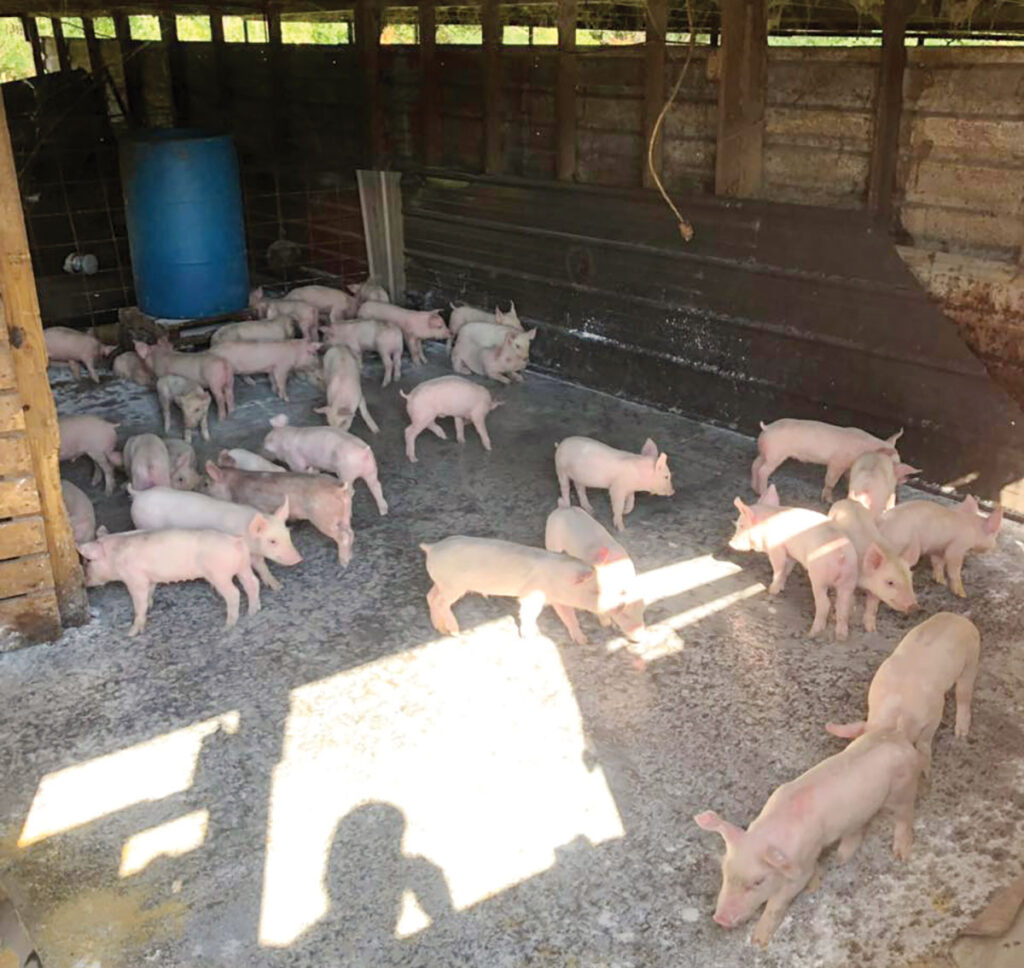
P-C Hog Farm LLC offers farm-raised pork to a growing customer base
JASPER, MO. – Growing up, Preston Walker was a self-described city kid. His first job, however, was at a farm.
“It was for a lady where I went to daycare,” he said. “I would do some odd and end farm chores. I was always outdoorsy, and as I got into high school, I started running around with guys who grew up on farms, and I liked it.”
When Preston and his wife Courtney bought 10 acres, which Preston said was mostly scrub brush, they decided to raise pigs.
“Growing up, my dad would smoke hogs for everyone’s birthday. That’s what you did; you had a get-together, smoked a hog and threw horseshoes,” Preston said. “I was working for a feed mill and delivering to a sow farm; it was kind of mind-boggling. These people were going through 30,000 pounds of feed every 10 days, and it was neat to see. I started asking questions about what it takes to raise pigs. We started with four piglets and have grown from there.”
That was about 10 years ago, and those first pigs led to the birth of P-C Hog Farm, LLC seven years ago, where the couple produces high-quality pork. On average, they finish 75 pigs annually, offering customers wholes and halves.
“When we started, I bought feeder pigs from a gentleman I learned a lot from,” Preston explained. “For about two or three years, we would buy feeder pigs, then fatten them out to butcher. Then, I decided we would farrow out our own. We got some gilts, raised them, and then had sows for a few years. In the long run, buying pigs is cheaper, so we went back to that. But now, especially in this day and age, we are raising some gilts so we can farrow out again because pigs are getting hard to find.”
Finding the right breed for the operation took some time, but the couple settled on a highly productive cross.
“We’ve tried some heritage breeds and some heritage crosses,” Preston said. “We are running a commercial-style pig, a Landrace/Duroc cross. A lot of people will say they don’t want commercial pigs. We aren’t running it like a commercial operation; we are just raising commercial pigs. They grow out very well, and the genetics are phenomenal, and they taste great.”
Purchased pigs are all born on the same farm. Knowing the genetics of the pigs they are buying and the quality of those animals helps the Walkers keep their finished product consistent.

As the business has grown, so has the number of pigs raised at P-C Hog Farm. Initially, the Walkers had litters twice a year and were finishing 15 to 20 pigs at a time. Then, they opted to only offer pigs once a year.
“You work hard for six months, then done for the rest of the year,” Preston said. “Then we put in a raised floor barn, and we had more people wanting pigs, so we went back to twice a year.”
The addition of the raised feeding floors, Preston said, has improved the cleanliness of the operation.
“We were already no antibiotic, no hormone. The floor has helped so much in overall health that we don’t have to worry about parasites and things because all the manure is going underneath,” he explained. He added if a pig needed treatment, it is separated, and medication is administered. Treated animals are retained for family use or sold to a customer who has no preference regarding antibiotic use.
Prior to their arrival at P-C Hog Farm, feeder pigs are vaccinated against viruses such as circovirus and mycoplasma pneumonia, but no other vaccinations are administered.
For 2023, the Walkers have 41 processing slots for spring and 25 so far for fall hogs, with an additional 25 appointments expected.
“With us being able to go back to twice a year, we’re going to have some room to get some new customers,” Preston said. “In the spring, those hogs and appointments are all spoken for, a deposit paid. For the fall hogs, which are September/October appointments, I will put the word out in January that we have X number of hogs available. If someone wants one, they can put down a deposit, and we will raise that hog out. With the way feed costs are, I don’t want to sit on them.”
Pigs come to the farm at 3 weeks of age, weighing between 8 and 10 pounds, about six months before their processing dates. Pigs receive a 16-percent protein corn and soybean mix with an added mineral pack. They remain on the same feed until processing. The Walkers avoid hogs going off feed by never changing their feed.
“I was feeding sows, and I noticed the babies were there eating momma’s feed,” Preston said. “I thought, why would I change their feed when I wean them when they are used to it? That is one less stressful factor, and they have always done well on it, so I go with it.”
Pigs are sent to the processor as they are finished and as slots are available.
“When you have a barn full of pigs, you try to get your biggest ones out first,” Preston explained. “We see our weights range between 260 and 350. As long as the pigs are good enough, they go.”
In addition to finished hogs, some feeder pigs and lightweight hogs are also offered to customers.

“When we sell them as feeder pigs, they will be about 20 pounds, that way, they get over weaning, and we make sure they are healthy. When I start selling feeder pigs off my sows, they will be 4 weeks old. With us being smaller producers, I will be putting feed out when they are 7 to 10 days old. Those 4-week-old pigs will be in the 20- to 28-pound range. We wean at 4 weeks, then I will give them about three days, then I cut boars. I will wait four to five days before I sell them to ensure they are healed up and doing well.”
Gilts are sold at 4 to 5 weeks of age. Some of those gilts go onto other farms to become replacement sows.
“I would be willing to sell some boars once we start farrowing our again,” Preston said.
Preston said they plan to limit the number of sows, despite adding a farrowing program back into their production.
“It’s scary to expand anything with feed prices,” he said. “I’m not opposed to getting bigger, but I don’t see the farrowing program getting bigger. The butchering, if all were to go well and I’m able to get the spots at processing facilities, I’m willing to expand.
“We have gained more new customers over the last two years, so if we keep growing our customers, we will expand.”







